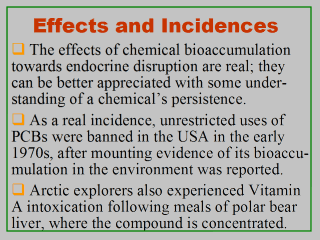| front |1 |2 |3 |4 |5 |6 |7 |8 |9 |10 |11 |12 |13 |14 |15 |16 |17 |18 |19 |20 |review |
 |
The effects of
chemical bioaccumulation towards endocrine disruption can be very dreadful.
Yet without some understanding of the persistence properties of the
environmental endocrine disruptors, which is the main topic covered in the
third and final part of this lecture, such disruption effects cannot be
appreciated fully. Until then, it is suffice to say here, though, that
chemical bioaccumulation is not just a theoretical construct, it is really
happening. For example, PCBs were once widely used in heat-transfer and hydraulic systems, and in products such as plasticizers, rubbers, lubricant inks, adhesives, waxes, fire retardants, paint additives, and dielectric fluids. In the USA, unrestricted uses of PCBs were initially banned in the early 1970s, after mounting evidence of its persistence and bioaccumulation in the environment was reported (Madsen et al., 2003). The most dreadful effect of chemical bioaccumulation is the fact that some substances can be accumulated to toxic levels in organisms when otherwise they are present below these levels. The classic case is the Vitamin A that becomes concentrated in polar bear livers. Vitamin A is a family of fat-soluble compounds, including the steroid hormone retinoic acid. Polar bears are pure carnivores that feed on other fish-eating carnivores such as seals. As they are at the top of the food chain, polar bears often accumulate extremely large amounts of Vitamin A in their livers, as many as 3,000 times the recommended daily allowance. It is a well-known case to many nutritionists that in the past, some Arctic explorers had experienced Vitamin A poisoning following meals of polar bear liver (e.g., Roels and Lui, 1973). Go to Part III of this lecture
|